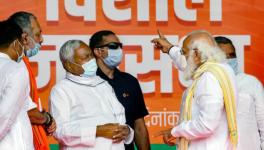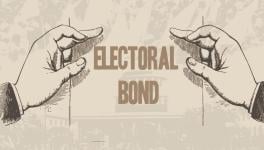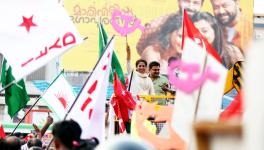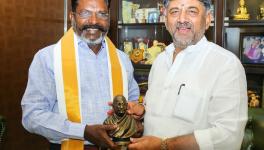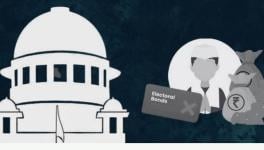Lingayat Religion Status: From an Egalitarian Philosophy to a Political Tool
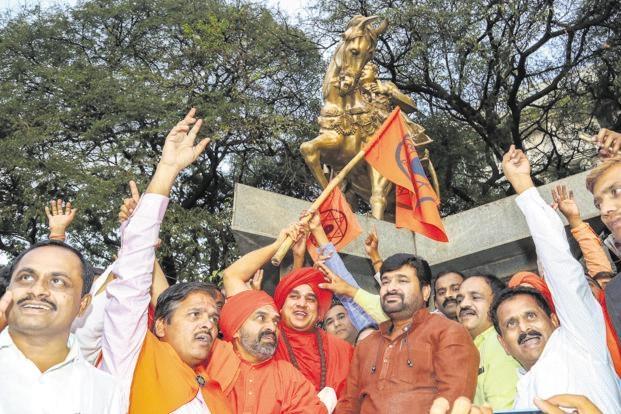
Image Courtesy: Livemint
The Siddaramaiah led Congress government of Karnataka has decided to extend the religious minority status for the Lingayat community, after persistent demands. Who are the Lingayats? And, who are Veershaivas? Why separate religion? And, what, if any, impact will this have on the upcoming Assembly elections? Indian Writers' Forum and NewsClick’s Yogesh S. talked to Shivsundar, a long time associate of Gauri Lankesh and former columnist of the Gauri Lankesh Patrike, to know more about these questions. Excerpts:
Yogesh (YS) : Could you tell us about the genesis of Lingayat movement?
Shivsundar (SS): Lingayata means, to worship ishta Linga outside a temple by placing it on one’s body. This meant that one’s body was to be considered as a temple. Shiva and not Vishnu was the main deity of shudras back in the 11-12th centuries and Linga is the form in which he is worshipped. Lingayat Dharma emerged as a resistance to the Vedic Hindu Dharma firstly by asking people to look for god in one self and hence worship (respect) one’s own body thus making the role of the middle man (Brahmin) unnecessary; and secondly by advocating that god is present in everyone irrespective of their caste and gender, thus making caste and gender based discrimination wrong. This can be seen as an attack on both the ritualist and spiritual ways of Vedic Hindu religion.
The main proponents of this dharma were Basavanna, Allamaprabhu, Akkamahadevi and others. Basavanna is considered to be the initiator of this movement against the hegemonic vedic Hindu order. He was finance minister in the court of King Bijjala II of Basavakalyan. Bijjala himself was a Shudra king, belonging to the barber caste, because of which probably, he was tolerant towards this radical philosophy of Basavanna. He allowed Basavanna to establish Anubhava Mantapa, a spiritual parliament which hosted people from different castes and backgrounds meeting everyday or once a week. Mostly they were of artisan castes, as Bijjala’s kingdom was an emerging centre of trade and hosted many artisan castes. Basavanna’s caste is contested: some say he was a Dalit but the popular belief is that he was a Brahmin who fought against the caste system and Brahminism. He initiated an ethic based, anti-vedic community. This continued for around twenty to thirty years.
Basavanna’s efforts caused unrest in the Brahmin community which opposed the socio-cultural reforms that Basavanna envisaged and encouraged others to practise. The intercaste marriage between a Dalit boy and a Brahmin girl which was initiated by Basavanna and the other Sharanas (his followers) resulted in a bloody, violent backlash from the Brahmins. Some of the Sharanas were butchered by the enraged people, and some fled Kalyana and it is believed that Basavanna committed suicide.
Following this, the Brahminical Hindu religion converted the Lingayat Dharma into one of the castes, though a dominant one. This is its origin. Many Sharanas continued to protest this institutionalisation of the dynamic thought called Lingayat Dharma as a caste, starting from the 12th century up to the 18th century.
YS: Lingayat Dharma got co-opted into the Hindu dharma as a caste. When did the demand for a separate religious status arise and who initiated it?
SS: By the 15th century Lingayat Dharma was part of the Hindu order. Shiva was also worshiped by the Shaivites of the Hindu religious order. There are many sects within Shaivism, one of them being the Veerashaivas. Since Lingayats were also worshippers of Shiva they got pushed into the sect of Veerashaiva although there was opposition to this development. By 16th and 17th century we get to see Lingayats merged with Veerashaivas. Lingayats were argued to be Veerashaivas but were considered to be on a lower rung of the Veerashaiva community. In 20th century, we see the economic growth and prosperity of the Lingayat community. In 1920 Bahu Halakatti with an aim of reviving the cultural identity of Lingayats, started exploring Vachanas and bringing forth the egalitarian philosophy. This is when the idea of the difference between Lingayats and Veerashaivas came to the fore in discussions. Associating their history to vachanas they perceived of an egalitarian caste identity and this became a tool to protest the lower caste status they had in the Veerashaiva fold. Hence their fight was for an upper caste status.
This is clear from the demands they raised with the British Raj. There used to be hostels for students and others during the British raj. Kitchens in these hostels were different for Brahmins and shudras. Lingayats were demanding for a separate kitchen by refusing to share the kitchen space with shudras. They also demanded Sanskrit education, which would make them sanskritised but retain the egalitarian identity - and this is a contradiction. Karnataka has a tradition of Mathas. They played a very important role in propagating that Lingayat philosophy was an egalitarian philosophy, most of the mathas in the northern Karnataka and rural mysore argued that they are not Veerashaivas who were equated to Brahmins.
When Karnataka state was formed in 1956, Lingayats were a powerful caste but continued to be under the Veerashaiva fold. They also tasted political power with many leaders like Nijalingappa being elected to the chief minister’s position. In 1980s during Ramakrishna Hegde’s regime they grew more powerful by establishing major engineering and medical colleges. Despite all this, they were still considered subordinate to the Veerashaivas culturally and socially. Other religious communities like Jains and Muslims were assigned a minority status and hence got various benefits. Hence the movement that started in 1980s was to say that Lingayats were not Veerashaivas. In the 1990s around two thousand mathas and their supporters submitted a memorandum to the then government to which BJP leaders B.S. Yeddyurappa and Jagadish Shettar were signatories. It was a full-fledged and continuous negotiation with the central government.
In August 2017 Siddaramaiah made it compulsory for all the government offices to have Basavanna’s photo in them. The Veerashaiva Mahasabha had many Lingayats in it and they were overjoyed with this decision of the Chief Minister and he was felicitated and this is when the lingayat leaders (Basava Dharma Yuva Sabha and others) put forth their demand for a different/minority religion status in the state. The CM in approval of this demand, suggested that they make a formal appeal. This was enough to bring together all the Lingayats resulting in an unprecedented mobilisation of the Lingayat seers and people demanding minority religion status. RSS and BJP have been vehemently opposing these developments.
In a Lingayat gathering of over three lakh people in Hubli, all the speakers ruthlessly attacked RSS supremo Mohan Bhagwat in their speeches and asked him to mind his own business and not poke his nose in the issues of other religions.
Yeddyurappa, the current BJP Chief Ministerial candidate, has said that he would welcome the stand of Veerashaiva Mahasabha. But the Mahasabha has welcomed the move of the current government. BJP and RSS are opposing the move and Veerashaiva Mahasabha has welcomed it - leaving Yeddyurappa in an interesting place.
YS: Going through the media reports, I learnt that Lingayats were the vote bank of BJP. Do you think this is true? If yes, was it because they were part of the Veerashaiva community which is based on vedic principles of caste based social order, the ideal system for BJP and RSS?
SS: Well, there is a little contradiction in this case. They were/are against the domination of Veerashaivas and Brahmanical social order but not against Hindu social order as a whole. There are some mathas which are progressive and are vehemently opposing RSS’s ideology but there are mathas who support their ideologies too. But none of them support BJP politically. So it is difficult to say if there has been a direct correlation between Lingayats being a vote bank of BJP because of being with Veerashaiva fold.
YS: In what ways will this decision have an impact on the upcoming election in the state?
SS: There are four things that Siddaramaiah's government has said:
- We accept the suggestions of the review committee and grant a separate religious status for Lingayat.
- Veerashaivas also will be granted a separate status.
- We will make sure that this move will not hinder any of the minority communities.
- We will implement this decision only after examining its possible impact on harmony in the state.
So this is not only for Lingayats. The Veerashaivas are happy too. For example: Shivashankarappa and his son who are in the Cabinet of Siddaramaiah are office bearers in the Akhila Bharatiya Veershaiva Mahasabha. They were against the idea of taking out Lingayats from the Veerashaiva fold and had suggested two options: one, give a separate religion status for both LIngayats and Veerashaivas or two, club Lingayat and Veerashaiva together into a community and give them a separate status. Siddaramaiah has chosen the first suggestion and has promised to recognise both Lingayat and Veerashaiva as minority religions. This move has protected the economic interests of Veerashaivas and has strengthened the vote bank of Veerashaiva allies of the Congress.
If at all this benefits some party, I would say it is going to benefit Congress and not JDS or BJP. I say this going by the voting pattern over the years. For example: Lingayats are a dominant community constituting the majority of the population in Belgaum and some other rural areas in Karnataka. After Yeddyurappa, Congress has seen 3% increase in their votes in this region and we should not forget that Lingayats were never completely against Congress. I think, this decision might help Congress in bagging more votes in this election and it is only the Congress that is going to be a beneficiary. But we cannot say that this decision is going to entirely influence the decision of the voters. We just have to wait and watch.
Get the latest reports & analysis with people's perspective on Protests, movements & deep analytical videos, discussions of the current affairs in your Telegram app. Subscribe to NewsClick's Telegram channel & get Real-Time updates on stories, as they get published on our website.









